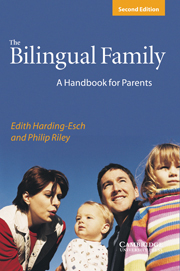Book contents
- Frontmatter
- Contents
- The authors
- Preface
- Part I A survey of the issues
- 1 Children and language
- 2 What is bilingualism?
- 3 Some things you should know about being bilingual
- 4 The development of the bilingual child
- 5 What will influence your decision whether to bring up your children as bilinguals?
- Part II Case studies: a number of bilingual families, and how they did it
- Part III An alphabetical reference guide
- Quotations
- Recommended resources
- Bibliography
- References
- Index
4 - The development of the bilingual child
Published online by Cambridge University Press: 29 March 2010
- Frontmatter
- Contents
- The authors
- Preface
- Part I A survey of the issues
- 1 Children and language
- 2 What is bilingualism?
- 3 Some things you should know about being bilingual
- 4 The development of the bilingual child
- 5 What will influence your decision whether to bring up your children as bilinguals?
- Part II Case studies: a number of bilingual families, and how they did it
- Part III An alphabetical reference guide
- Quotations
- Recommended resources
- Bibliography
- References
- Index
Summary
SIMULTANEOUS ACQUISITION
Most of what we know about the simultaneous acquisition of two languages by children is based on case studies or reports produced by parents-cum-linguists observing their own children. As often as not, these studies take the form of a ‘linguistic diary’ recording a child's development during all or part of her early childhood.
From a strictly scientific point of view, such a procedure has an obvious disadvantage, namely, that the results cannot really be regarded as objective or generalisable, since the parents, just because they are parents, may distort the results. None the less, improvements in recording techniques, and in particular the use of video and sound recordings, make such data not only increasingly reliable for research (Deuchar and Quay, 2000; Vihman, 1999) but extremely useful to would-be bilingual families, since they show that it has been done before, and done successfully.
By ‘successful’, we mean here that all the children who have been studied in this way have grown up to be perfectly ‘normal’, none of them having exhibited any sign of being disturbed by their experience. Moreover, these children, while usually dominant in one of their languages at the time their case was reported, were none the less able to use their other languages when circumstances required. This phenomenon has been observed frequently, although for the parents concerned there will, naturally enough, always be a sense of wonder when it happens. An example is given in Case Study 3: a monolingual German grandmother came to stay with her daughter, French son-in-law and grandson.
- Type
- Chapter
- Information
- The Bilingual FamilyA Handbook for Parents, pp. 50 - 76Publisher: Cambridge University PressPrint publication year: 2003



